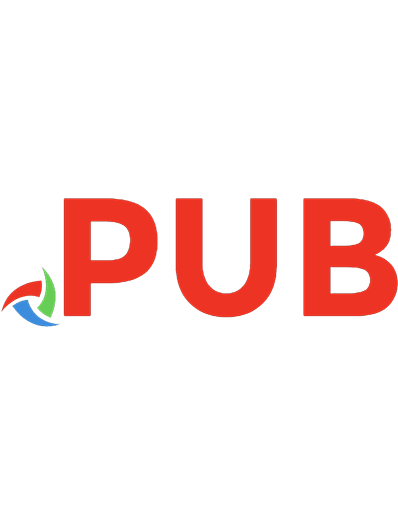Python Machine Learning - Second Edition [2nd ed] 9781787125933, 1787125939, 9781787126022, 1787126021
Key Features A practical approach to the frameworks of data science, machine learning, and deep learning Use the most po
404 80 27MB
English Pages 595 Year 2017
Table of contents :
Cover
Copyright
Credits
About the Authors
About the Reviewers
www.PacktPub.com
Customer Feedback
Table of Contents
Preface
Chapter 1: Giving Computers the Ability to Learn from Data
Building intelligent machines to transform data into knowledge
The three different types of machine learning
Making predictions about the future with supervised learning
Classification for predicting class labels
Regression for predicting continuous outcomes
Solving interactive problems with reinforcement learning
Discovering hidden structures with unsupervised learning. Finding subgroups with clusteringDimensionality reduction for data compression
Introduction to the basic terminology and notations
A roadmap for building machine learning systems
Preprocessing --
getting data into shape
Training and selecting a predictive model
Evaluating models and predicting unseen data instances
Using Python for machine learning
Installing Python and packages from the Python Package Index
Using the Anaconda Python distribution and package manager
Packages for scientific computing, data science, and machine learning
Summary. Chapter 2: Training Simple Machine Learning Algorithms for ClassificationArtificial neurons --
a brief glimpse into the early history of machine learning
The formal definition of an artificial neuron
The perceptron learning rule
Implementing a perceptron learning algorithm in Python
An object-oriented perceptron API
Training a perceptron model on the Iris dataset
Adaptive linear neurons and the convergence of learning
Minimizing cost functions with gradient descent
Implementing Adaline in Python
Improving gradient descent through feature scaling. Large-scale machine learning and stochastic gradient descentSummary
Chapter 3: A Tour of Machine Learning Classifiers Using scikit-learn
Choosing a classification algorithm
First steps with scikit-learn --
training a perceptron
Modeling class probabilities via logistic regression
Logistic regression intuition and conditional probabilities
Learning the weights of the logistic cost function
Converting an Adaline implementation into an algorithm for logistic regression
Training a logistic regression model with scikit-learn
Tackling overfitting via regularization. Maximum margin classification with support vector machinesMaximum margin intuition
Dealing with a nonlinearly separable case using slack variables
Alternative implementations in scikit-learn
Solving nonlinear problems using a kernel SVM
Kernel methods for linearly inseparable data
Using the kernel trick to find separating hyperplanes in high-dimensional space
Decision tree learning
Maximizing information gain --
getting the most bang for your buck
Building a decision tree
Combining multiple decision trees via random forests
K-nearest neighbors --
a lazy learning algorithm
Summary. Chapter 4: Building Good Training Sets --
Data Preprocessing.
![Python Machine Learning - Second Edition [2nd ed]
9781787125933, 1787125939, 9781787126022, 1787126021](https://dokumen.pub/img/200x200/python-machine-learning-second-edition-2nd-ed-9781787125933-1787125939-9781787126022-1787126021-y-8332129.jpg)
![Python Machine Learning - Second Edition [2nd ed]
9781787125933, 1787125939, 9781787126022, 1787126021](https://dokumen.pub/img/200x200/python-machine-learning-second-edition-2nd-ed-9781787125933-1787125939-9781787126022-1787126021-y-6217158.jpg)
![Python Machine Learning - Second Edition [2nd ed]
9781787125933, 1787125939, 9781787126022, 1787126021](https://dokumen.pub/img/200x200/python-machine-learning-second-edition-2nd-ed-9781787125933-1787125939-9781787126022-1787126021.jpg)
![Python Machine Learning Blueprints [2nd edition.]
9781788994170](https://dokumen.pub/img/200x200/python-machine-learning-blueprints-2nd-edition-9781788994170.jpg)
![Learning Python [2nd edition]](https://dokumen.pub/img/200x200/learning-python-2nd-edition.jpg)

![TensorFlow Machine Learning Cookbook: Over 60 recipes to build intelligent machine learning systems with the power of Python, 2nd Edition [Second edition]
9781789131680, 1789131685, 9781789130768, 178913076X](https://dokumen.pub/img/200x200/tensorflow-machine-learning-cookbook-over-60-recipes-to-build-intelligent-machine-learning-systems-with-the-power-of-python-2nd-edition-second-edition-9781789131680-1789131685-9781789130768-178913076x.jpg)
![Machine Learning with Python Cookbook, 2nd Edition (6th Early Release) [2 ed.]
9781098135720, 9781098135669](https://dokumen.pub/img/200x200/machine-learning-with-python-cookbook-2nd-edition-6th-early-release-2nbsped-9781098135720-9781098135669.jpg)
![Machine Learning with Python Cookbook, 2nd Edition [Early Release ed.]
9781098135720, 9781098135669](https://dokumen.pub/img/200x200/machine-learning-with-python-cookbook-2nd-edition-early-releasenbsped-9781098135720-9781098135669.jpg)
![Learning Python, 2nd Edition [2nd edition]
0596002815, 9780596002817](https://dokumen.pub/img/200x200/learning-python-2nd-edition-2nd-edition-0596002815-9780596002817.jpg)
